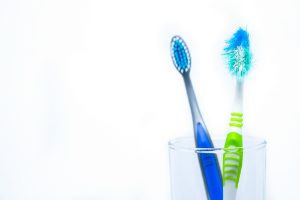 Time for a New Toothbrush?
Time for a New Toothbrush?
If it’s been a while since you replaced your toothbrush, it may be time to look for signs of aging. If it is badly worn or frayed, it may be doing more harm than good.
If you are unsure about the state of your toothbrush, just bring it in at your next appointment and we can assess the damage, discuss the variety of options, and/or review proper brushing technique.
Old Toothbrush Hazards
- Less Effective – A worn out toothbrush is simply less effective at removing plaque. A new brush works mush more efficiently.
- Risk of Re-infection – Viruses and bacteria love the moist environment of a toothbrush, and some viruses have been shown to remain active for as long as a week after you’re over the flu or a bout with cold sores. Just when you’re feeling better, an old toothbrush can be a source of re-infection. So after an illness, it’s always a good idea to get a new one.
- Risk of Injury – With proper brushing technique, only the very tips of bristles make contact with teeth. When a toothbrush is old and worn, frayed bristles can damage soft tissue. Very hard bristles may even cause gums to recede.
Toothbrush Recommendations
- Soft Bristles – When choosing a toothbrush, soft rounded bristles are ideal to gently polish teeth without causing injury
- Replace Them Regularly – While you may get more or less out of your toothbrush depending on your brushing style, a good rule of thumb is to replace it every 4-6 weeks.
- Use Proper Technique – Place the bristles beside your teeth, angled away from the gums at about 45-degrees. Gently brush teeth using a circular or elliptical motion, a couple teeth at a time as you gradually cover the entire mouth. Be sure to brush all parts of your teeth (outside, inside, chewing surfaces, and in between) and your tongue as well.
- Get a Second One – Staggering the use of your toothbrush gives it a chance to dry out between uses. This helps prevent fraying and extends its useful lifespan.

